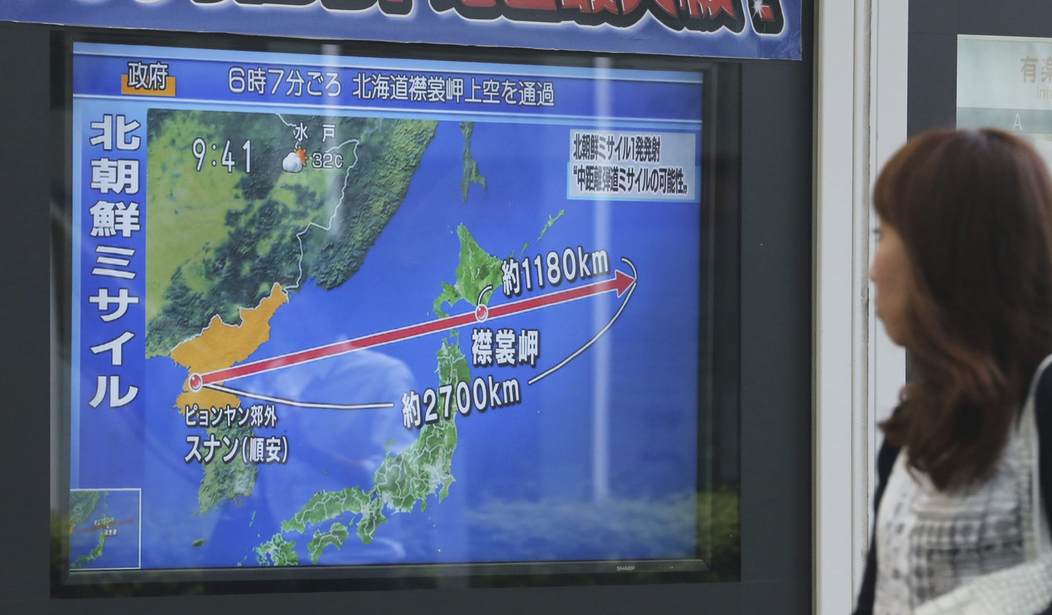North Korea launched a ballistic missile over Japan on Tuesday, an act that all by itself qualifies as a stunning provocation. This followed a bout of North Korean threats earlier this month to girdle Guam with missile strikes. Those threats followed North Korea’s successful tests last month of two intercontinental ballistic missiles. Those tests followed an 11-year span from 2006-2016 in which North Korea conducted five nuclear tests, prepared to conduct a sixth — which could come anytime now — and in 2010 unveiled a uranium-enrichment program to complement its production of plutonium for bomb fuel.
It should by now be possible to discern a certain amount of persistence in all this. But that did not discourage Secretary of State Rex Tillerson from finding a moment of relative calm, six days ago — sandwiched between the threats to Guam and the missile over Japan — to tell reporters:
I am pleased to see that the regime in Pyongyang has certainly demonstrated some level of restraint that we’ve not seen in the past. We hope that this is the beginning of this signal that we’ve been looking for that they are ready to restrain their level of tensions, they’re ready to restrain their provocative acts, and that perhaps we are seeing our pathway to sometime in the near future having some dialogue.
To be fair to Tillerson, he joins a long roster of American diplomats who over the years have tried to cope with the intractable problem of North Korea by seeing (or at least professing to see) what they want to see. Going back at least to the early days of the Clinton administration, Washington has developed rituals in which American officials proclaim that North Korea’s regime has a choice: to continue its rogue pursuit of nuclear weapons and suffer various penalties, or give them up and enjoy the many perquisites of life as a conventionally armed murderous totalitarian state.
It seems reasonable by now to say that North Korea’s regime made its choice decades ago, and has stuck with it — cheating its way out of a series of nuclear deals reached under Presidents Clinton and Bush, and availing itself of President Obama’s passive”strategic patience” to complete a transition of power from the late tyrant Kim Jong Il to his son, the current tyrant, Kim Jong Un, and accelerate its nuclear missile program.
Nor, despite the occasional week or so of apparent restraint, is there any sign that North Korea’s Kim regime intends to restrain itelf. Not least, nuclear weapons are enshrined in its updated 2012 constitution, which describes the Democratic People’s Republic of Korea as “a nuclear state and an unchallengeable military power.”
And, of course, nuclear missiles are not the only weapons Pyongyang is cultivating. Last Wednesday, during the brief lull in missile tests that inspired Tillerson to talk about North Korean restraint, the Washington Free Beacon reported that the Department of Homeland Security and the FBI had just issued a new warning that “North Korean hackers are continuing to target critical U.S. infrastructure for cyber attacks.”
The Free Beacon story included a link to a DHS bulletin that provides technical details on “the tools and infrastructure used by cyber actors of the North Korean government to target the media, aerospace, financial, and critical infrastructure sectors in the United States and globally.” The U.S. government refers to this malicious North Korean activity under the enticing name of HIDDEN COBRA.
And a few days before the HIDDEN COBRA cyber warning from DHS, Reuters reported — on the chemical weapons front — that “two North Korean shipments to a Syrian goverment agency responsible for the country’s chemical weapons program were intercepted in the past six months, according to a confidential United Nations report on North Korea sanctions violations.”
Those recent examples of North Korea’s cyber endeavors and chemical weapons-related traffic would be alarming even in the absence of a North Korean nuclear weapons program. But in the roster of North Korean threats, they are just a sampling of the activities of the era. Recall the assassination with VX nerve agent of Kim Jong Un’s half-brother, Kim Jong Nam, this past February, in a Malaysian airport.
Reports and testimony on North Korea’s weapons trafficking, assorted arsenals, and mendacious, menacing or outright murderous acts have piled up over the years so high, wide and deep that by now they might usefully be repurposed as bomb shelters. North Korea’s regime is by its basic totalitarian character unrestrained by the norms required for a civilized world order. Its continued existence, and growing threat, serves by now to embolden a rising network of other despotisms, notably China, Russia and Iran.
The real choice belongs to Washington. The U.S. can decide that it is willing to live with the rising risks of a North Korean regime that is honing its cyber warfare abilities, selling weapons and related technology around the globe, threatening nuclear strikes on U. S. territory, developing nuclear-tipped ICBMs, just lobbed another missile over Japan and will cheat on any deal. Or the U.S. can decide, before the dangers get even worse, that the real mission is to seek a course that would finally bring an end to North Korea’s totalitarian Kim regime.









Join the conversation as a VIP Member